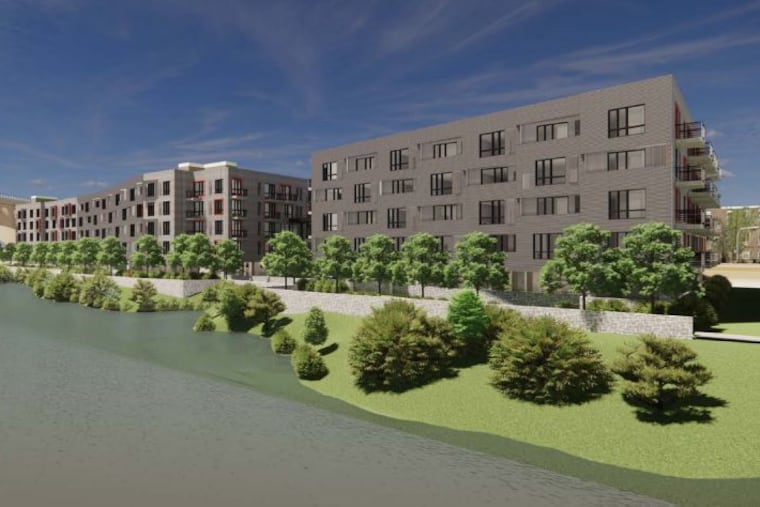Controversial 213-unit residential development on Venice Island is moving forward
Manayunk's Venice Island is expected to see another large apartment development, despite flooding concerns.

Philadelphia residents got a new look this week at a 213-unit apartment development proposed for Venice Island, a sliver of land between the Schuylkill River and the Manayunk Canal.
Despite the site’s vulnerability to flooding, the project can move forward with few additional approvals. Concerns about development on Venice Island have circulated for years. The island is in the 100-year flood plain, and inundations are more regular than that term suggests.
The company behind the apartment project, Rock Urban Development, designed a project that they believe accounts for the site’s climate-changed augmented challenges. The first floor is devoted to parking, with an early warning system to alert residents of approaching danger. The bulk of the structure itself is a foot and a half above the floodplain. A pedestrian bridge will connect the building to Manayunk’s Main Street, allowing for an emergency exit.
“In the event of needing to evacuate, this is all above floodplain, but we need to make sure that people can get out safely,” said Jerry Roller, founder of the architecture firm JKRP, which designed the project. “This [bridge] safely accesses Main Street, which based on the last flood event was not underwater.”
Roller repeatedly stated that his firm and Rock Development have consulted with the city and worked within Philadelphia’s larger plans for floodplain management. But while city planners are powerless to change the project — the planning commission and its staff only have an advisory role — they took little solace in the fact that Main Street Manayunk did not flood as badly as Venice Island during last year’s Hurricane Ida.
Both city staff and appointed members of the Civic Design Review committee, which reviewed the project Tuesday, noted that the pedestrian bridge exits onto an area that is in the 500-year floodplain.
“You need to think in terms of the worst case scenario,” said Ashley DiCaro, an urban designer who sits on the CDR committee, “so we can make informed decisions about developing on this land — if we’re going to still allow that.”
Historically Venice Island was home to industrial uses, but in 1999, then-Councilmember Michael Nutter rezoned the area for residential development.
Manayunk is a popular neighborhood, with limited space for new development and zoning regulations on major thoroughfares that hamper new projects in those locations. The island affords views of the water and easy access to the Schuylkill River Trail, which goes all the way through Valley Forge National Historic Park. The proposed development is an easy walk to most of the neighborhood’s popular bars, coffee shops, and restaurants.
But residents of Venice Island, which already has 260 residential units, have faced catastrophic flooding repeatedly in the past few decades and, in one incident, had to be rescued by boat.
“Looking at the last flood, [when] the island completely flooded, that area [Main Street] didn’t and that gives us a sense that this is an area that doesn’t flood as badly,” Roller said, referring to last year’s Hurricane Ida. “Clearly, we’re conscious of [this issue], and we have worked with the city in terms of their approach to floodplain management and they’re in agreement with what we’re proposing.”
Roller outlined other plans for the site as well, which include the expansion of the existing one-lane bridge that connects Main Street to the parking lot and abandoned auto-detailing shop on the location. The developer plans to widen that bridge to allow for two-way car traffic as well as pedestrian activity.
The development team will return for a second session with the Civic Design Review committee to answer more questions from the panel of experts. Because the Manayunk canal is overseen by the Parks and Recreation Department, the developers then will have to seek approval for their bridge proposals from the city’s Art Commission, which oversees development in Philadelphia’s parks.
Roller also noted that the 110 parking spaces planned for the project represented “a tremendous amount of parking.” He said the developer had to follow hyper-local zoning regulations that require more parking around Main Street Manayunk than in most other areas of Philadelphia.
“We have an awful lot of spaces here,” he said. “But the expectation is that there will be spaces for vehicles to load, there will be visitor spaces, because we don’t think we need all this for our actual residents.”